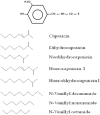Chemical and pharmacological aspects of capsaicin
- PMID: 21278678
- PMCID: PMC6259610
- DOI: 10.3390/molecules16021253
Chemical and pharmacological aspects of capsaicin
Abstract
Capsaicin is a unique alkaloid found primarily in the fruit of the Capsicum genus and is what provides its spicy flavor. Generally extracted directly from fruit, high demand has driven the use of established methods to increase production through extraction and characterization. Over time these methods have improved, usually be applying existing techniques in conjunction. An increasingly wide range of potential applications has increased interest in capsaicin. Especially compelling are the promising results of medical studies showing possible beneficial effects in many diseases. Capsaicin's pungency has limited its use in clinical trials to support its biological activity. Characterization and extraction/ synthesis of non-pungent analogues is in progress. A review is made of capsaicin research focusing mainly on its production, synthesis, characterization and pharmacology, including some of its main potential clinical uses in humans.
Figures




References
-
- Bernal M.A., Calderon A.A., Pedreno M.A., Muñoz R., Ros Barceló A., Merino de Caceres F. Capsaicin oxidation by peroxidase from Capsicum annuum (variety Annuum) fruits. J. Agric. Food Chem. 1993;41:1041–1044. doi: 10.1021/jf00031a004. - DOI
-
- Walpole C.S., Bevan S., Bloomfield G., Breckenridge R., James I.F., Ritchie T., Szallasi A., Winter J., Wrigglesworth R. Similarities and differences in the structure-activity relationships of capsaicin and resiniferatoxin analogues. J. Med. Chem. 1996;39:2939–2952. - PubMed
-
- Kobata K., Kawamura M., Toyoshima M., Tamura Y., Ogawa S., Watanabe T. Lipase-catalyzed synthesis of capsaicin analogs by amidation of vanillylamine with fatty acid derivatives. Biotechnol. Lett. 1998;20:451–454.
-
- Nelson E.K., Dawson L.E. The constitution of capsaicin, the pungent principle of Capsicum. III. J. Am. Chem. Soc. 1923;45:2179–2181.
-
- [accessed on 28 January 2011]. Available online: http://www.3dchem.com/molecules.asp?ID=105.
Publication types
MeSH terms
Substances
LinkOut - more resources
Full Text Sources
Other Literature Sources

